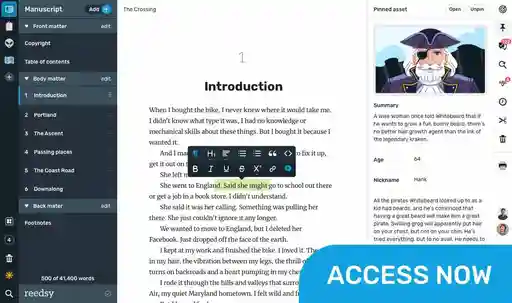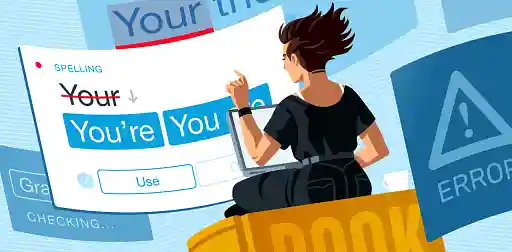Last updated on Oct 15, 2025
What Is Purple Prose? Writing 101: Definition, Tips, and Examples
Martin Cavannagh
Head of Content at Reedsy, Martin has spent over eight years helping writers turn their ambitions into reality. As a voice in the indie publishing space, he has written for a number of outlets and spoken at conferences, including the 2024 Writers Summit at the London Book Fair.
View profile →Purple prose is a style of writing characterized by overly flowery language that tends to draw attention to itself, and away from the story being told. Its typical features include excessive adjectives, exaggerated comparisons, multisyllabic words, long sentences, and elaborate descriptions of a character’s inner thoughts and feelings.
For writers attempting to use poetic language, purple patches are a common problem as they slow a book’s progression, muddle the plot, and create an unintended melodramatic tone that reduces the work’s power.
Here’s an example of purple prose:
The mahogany-haired adolescent girl glanced fleetingly at her rugged paramour, a crystalline sparkle in her eyes as she gazed, enraptured, upon his countenance. It was filled with an expression as enigmatic as receding shadows in the night. She pondered whether it would behoove her to request that she continue to follow him on his noble mission…
Yikes, right?
Purple prose doesn't always persist throughout the entirety of a piece — it can also pop up every so often in “purple patches” — but even a few "purple passages" can be disruptive.
Think of purple prose as a cardboard cutout of a celebrity. From a distance it looks convincing, even impressive — but as you draw closer, you realize there’s nothing behind it. Purple prose is like that: beautiful from afar, with very little substance to it.
What purple prose is not
To clarify, the term “purple prose” doesn’t just automatically apply to any kind of dense or elaborate language. This is a common misconception, perpetuated by diehard fans of minimalism and Ernest Hemingway. Purple prose specifically refers to overblown description that fails to add to the text, or may even detract from it.
Q: What's the best piece of writing advice for an author who wants to improve their craft?
Suggested answer
Join critique groups! These were invaluable to me when it I started writing and even taught me how to edit! Reading books will become dated with old advice, so stay up to date with blogs, trends, audiences, and read, read, read!
Stephanie is available to hire on Reedsy ⏺
Practice and read!
In the same way that you need to practice a musical instrument to get better, you need to do the same with writing too. Very few writers will publish the first book they ever write!
The other thing that will help you to improve your writing craft is reading. Read the books that are selling well in your genre right now, not just the bestsellers from a decade ago. Study them. Look at the reviews for these books and listen to what readers are saying.
There are loads of brilliant books that will help you to write an effective novel as well (Into the Woods by John Yorke, The Science of Storytelling by Will Storr, Story Genius by Lisa Cron and Save the Cat Writes a Novel by Jessica Brody are a few of my favourites). Even if you don't agree with everything they say (I don't necessarily agree with every piece of advice in the above!) it's so helpful to see a range of different perspectives. You'll also quickly be able to see the patterns and advice from these books in the bestsellers you read. There are also loads of podcasts, blog posts, YouTube videos and audiobooks out there too, as well as Reedsy's own masterclasses!
Siân is available to hire on Reedsy ⏺
So for example, the language Virginia Woolf uses in her books is flowery, but that doesn't mean it's purple. Her consistently elaborate prose doesn’t detract from the story. Rather, it contributes to her signature stream-of-consciousness narrative style:
One feels even in the midst of the traffic, or waking at night, Clarissa was positive, a particular hush, or solemnity; an indescribable pause; a suspense (but that might be her heart, affected, they said, by influenza) before Big Ben strikes. There! Out it boomed.
Likewise, David Foster Wallace’s writing may be difficult to decipher due to its density, but it’s certainly not devoid of meaning:
What passes for hip cynical transcendence of sentiment is really some kind of fear of being really human, since to be really human [...] is probably to be unavoidably sentimental and naïve and goo-prone and generally pathetic.
“Purple prose” is often used as an insult for highly lyrical or complex language that some readers dislike. But don’t be fooled — actual purple prose lacks the elegance and cohesion of these examples, and distracts from the text rather than enhancing it.

Free course: How to self-edit like a pro
Rid your manuscript of the most common writing mistakes with this 10-day online course. Get started now.
Examples of purple prose
In this section, we’ll look at various samples of purple prose in published work and try to revise them. You’ll notice that all of these passages have slightly different problems, which can be addressed via distinct methods to help them read in a smoother and more satisfying manner.
Q: What are the most common tonal issues in early manuscript drafts, and how can authors address them?
Suggested answer
Tone – is the mood of a scene or story, in general. It’s like a bag of tricks containing style, voice and expectation. It promises a specific experience.
Emotional imbalances – create discord in the tone when a protagonist laughing or thinking something is funny when something sad or difficult has happened do not gel. It could be they have a dark/offbeat sense of humor, but this needs to have been conveyed for the above to work, so the reader stays immersed instead of stopping and thinking, eh?
Skewed focus – detracts from intended tone when, for example, authors use too much minute detail during a (high-tension) scene where you’ve got to exit the box before your air runs out! This upsets focus as we’re not interested in the wallpaper motif right now. Add sensory details relevant to the conflict, not ones that detract. Generally, you only need a basic amount of detail for a scene to be plausible and effective. Overdoing it misdirects and kicks out your pace and tension, which are part of the tone.
Tense – switching tense and POV format interfere with the author’s writing style and the voice of their narrator(s). Present to past tense in the same paragraph, and first to third person POV intermittently is jarring and ruins the way you tell. Your story unfolds and your characters talk on the stage you give them, but for this to remain intact, keep your tense clear. Not defining this means the reader cannot focus on which time or telling we are in and your tonal stage falls apart.
Voice – monotony. Character diction (word choice), sentence structure (simple or complex) and syntax (word arrangement) should be individual. If Jed and George both use street vernacular, one can express in a sharper, snappier tone, the other could use a more probing, gentler approach. Their tones steer reader insight and color perspective, populating the story with personality. If everyone speaks the same way, the effect is monologuing.
Tone or tune rainbow – excess shifting of dramatic tone alienates your reader. For a sinister thriller, overuse of slapstick comedy and romantic intrigue distorts reader expectation, just as whimsical reverie to hardboiled crime could be a choke. Not that you can’t have wild and wonderful swings! But the tones you use should suit your overall concept. Perhaps think of your work as a piece of music. Plotting your story as a tune with rhythm, tempo, key, etc. can aid 'tonal shifts' — and help compose the hues of your intentions and your reader's feelings.
Agatha is available to hire on Reedsy ⏺
Characters who sound the same is probably one of the most common tonal issues I see. If your characters all sound the same, none of them stick out, which creates a flattened tone throughout the story. Some writers will add (and write the text in) accents, but if overdone, this can be jarring and an obvious attempt to try to distinguish the characters from each other. It's more important to concentrate on the things the characters say, not how they say them. The content and syntax of their dialogue should be the thing that distinguishes them, more than any stutter or accent you give them.
Brett is available to hire on Reedsy ⏺
Eldest (Book 2 in The Inheritance Cycle)
Though Christopher Paolini’s dragon-centered fantasy series was a big hit with the YA crowd, it’s also the victim of some serious purple patches. This is especially true for Paolini’s second book, Eldest, which follows the characters established in his first book Eragon.
The following passage is taken from chapter 2, The Council of Elders:
Saphira’s muscled sides expanded and contracted as the great bellows of her lungs forced air through her scaled nostrils. Eragon thought of the raging inferno that she could now summon at will and send roaring out of her maw. It was an awesome sight when flames hot enough to melt metal rushed past her tongue and ivory teeth without harming them.
Problem: Excessively ornate description
Solution: Reduce adjectives, verbs, and sentence length
Revised passage: Saphira breathed heavily, her nostrils expelling warm air. Eragon sat and marveled at her power. It was amazing that Saphira's fiery breath could melt metal, yet she was immune to its harm.

Bob Honey Who Just Do Stuff
Sean Penn’s 2018 debut novel left critics flummoxed, and not just because of its unusual plot — it’s also chock full of purple descriptions that had readers scratching their heads. Though Bob Honey is supposed to be satirical, that doesn’t explain or justify the nearly inscrutable language Penn employs.
From chapter (or “station” as Penn labels it) 13:
There is pride to be had where the prejudicial is practiced with precision in the trenchant triage of tactile terminations. This came to him via the crucible-forged fact that all humans are themselves animal, and that rifle-ready human hunters of alternately-species prey should best beware the raging ricochet that soon will come their way.
Problem: Very difficult to decipher
Solution: Use simpler words and clarify references
Revised passage: Bob Honey suddenly realized that humans are animals too. We should all be thoughtful and deliberate in the act of hunting, he understood — for we can easily become the hunted ourselves.
Q: How are single-sentence paragraphs in fiction used to enhance pacing or tone?
Suggested answer
Single-sentence paragraphs, when used effectively, can create powerful moments in fiction by emphasizing key details, heightening tension, or evoking strong emotions. This technique draws readers’ focus, often slowing down the pace or giving weight to an important revelation.
For example, in a tense scene, consider: *The lights went out.* By isolating this line, the narrative pauses, and the suspense becomes almost palpable, leaving readers to share the character's dread. In moments of deep emotional impact, a single-sentence paragraph can hit hard: *She let the letter fall.* Here, the simplicity and isolation emphasize the weight of her decision or reaction.
They also work well for sudden realizations or turning points. For instance: *He’d been wrong all along.* This makes the revelation stand out, inviting readers to pause and reflect on its significance. In emotionally charged scenes, such as when a character grapples with loss or shock, a single line like *It was over.* can convey a raw, visceral punch.
By breaking the rhythm of surrounding text, these sentences create dramatic pauses, emphasize shifts, and linger in the reader's mind. When used sparingly, they can make pivotal moments unforgettable and keep readers deeply engaged.
Eilidh is available to hire on Reedsy ⏺
I always suggest to authors to put particularly important or impactful sentences on their own line. They work to highlight the sentence, which helps cement it in readers' minds, as opposed to it being just another sentence in a big block of text. Used judiciously, of course. If overused, it will lose its impact.
Brett is available to hire on Reedsy ⏺
It's about pacing.
Single-sentence paragraphs can be very effective in creating rhythm for the reader, whether it's moving quickly through action with a series of short paragraphs, or creating a break between longer paragraphs to make an idea, image or action stand out. Whatever the use, it should be thought-out and deliberate, otherwise it risks reading as choppy and awkward.
Margot is available to hire on Reedsy ⏺
My Immortal
My Immortal: the infamously terrible piece of fanfiction that changed the Internet forever. Besides its myriad of structural and plot-based issues, My Immortal also suffers from purple prose. Here is a particularly cringeworthy passage from Chapter 8:
My friend B'loody Mary Smith smiled at me understatedly. She flipped her long waste-length gothic black hair and opened her crimson eyes like blood that she was wearing contact lenses on. She had pale white skin that she was wearing white makeup on. Hermione was kidnapped when she was born. Her real parents are vampires and one of them is a witch but Voldemort killed her mother and her father committed suicide because he was depressed about it.
Problems: Unnecessary aesthetic details, run-on sentences, confuses reader and muddles plot
Solution: Delete passage and restructure entire piece. Some prose is so bad that it’s not worth trying to fix — fortunately, My Immortal is such an outlier that almost nobody need resort to such extreme tactics.
The purple prose of My Immortal is still remembered as legendarily awful #memorylane
Click to tweet!
4 tips for avoiding purple prose
Since purple prose is a hallmark of poor writing, you want to avoid it at all costs. Unfortunately, it’s all too easy to fall into the “purple trap,” especially as a novice writer trying to develop a sophisticated style. For those concerned, this section will give you some ground rules to help you avoid that flowery demon of writing.
1. Write in your own voice — not someone else’s
This is the most essential tip to remember if you’re worried about purple prose. Because purple patches result from trying to sound more “literary,” they often crop up when you’re attempting to imitate a more advanced writing style.
While it’s great to have writing role models, no one likes a copycat — especially when your impression consists of long, ostentatious descriptions. So if you find yourself writing purple prose because you’re trying to sound like someone else, stop and reevaluate. You’re likely mimicking another writer’s voice because you’re struggling to find your own.
Q: What are the most common mistakes writers make when breaking up paragraphs, and how can they improve readability?
Suggested answer
In fiction, the most common--and confusing!--issue I see with paragraph breaks occurs in conversations between characters. Authors almost always follow the rule of starting a new paragraph with each change in speaker, but sometimes, action beats (phrases describing what a character thinks or does) don't follow the same guidelines. This affects clarity: readers can lose track of who says what when character A's dialogue and character B's actions appear in the same paragraph. Check out this example:
"I'm not convinced," Barker said.
"But the DNA doesn't lie. And the soil traces exactly match the vic's compost."
Clark shifted in his chair, leaning to snag the soil analysis from Barker's desk. "Can't argue with that," he said, "but there's still the Ring footage."
That last sentence was actually spoken by Barker, not Clark, but the placement of the action beats muddies the exchange. One simple paragraphing adjustment fixes the issue, with no rewriting needed:
"I'm not convinced," Barker said.
"But the DNA doesn't lie. And the soil traces exactly match the vic's compost." Clark shifted in his chair, leaning to snag the soil analysis from Barker's desk.
"Can't argue with that," he said, "but there's still the Ring footage."
Stephanie is available to hire on Reedsy ⏺
The biggest mistake an author can make when breaking up paragraphs is failing to maintain clarity and flow. Paragraphs are essential for structuring writing (whether this be fiction or non-fiction!), and poor paragraphing can confuse or disengage readers. Key errors include overcrowding paragraphs with multiple ideas, resulting in overly long, run-on paragraphs which overwhelm readers or breaking paragraphs too frequently, resulting in a choppy, disjointed narrative (where not used for effect).
A typical rule of thumb suggests a well-crafted paragraph should convey one central idea, action or theme. Authors should begin a new paragraph whenever introducing a new topic, thought or perspective. In fiction, this includes changes in setting, time or action and each time a new character speaks during dialogue. For non-fiction, paragraphs should align with shifts in argument or explanation.
Varied paragraph lengths can enhance rhythm and readability. Short paragraphs are impactful and ideal for highlighting key moments or emotions. Longer paragraphs, however, can delve into detail or explore complex ideas. Not varying length can disrupt your balance and writing’s overall engagement.
It’s also important to consider overall readability. Large blocks of text are visually intimidating and harder to process. Modern writing often benefits from concise, three-to-five-sentence paragraphs (although deviations for stylistic purposes are acceptable). On the other hand, breaking a paragraph prematurely—especially without completing an idea—can confuse readers and diminish the narrative’s flow. Similar to this, the transitions between your paragraphs also matter. Smooth shifts can be achieved through linking phrases, repeated keywords or logical progression of ideas, effortlessly guiding readers through the story.
As indicated above, a common error I’ve noticed in clients’ work comes in their writing dialogue. Failing to start a new paragraph for each speaker creates confusion and uncertainty. Consistently breaking paragraphs for dialogue improves clarity, helping readers follow the conversation and imagine the scene in real time, creating enhanced drama, tension or even humour.
Ultimately, paragraphing is both a technical and stylistic skill. Experienced writers often break conventions intentionally to suit their voice or genre and this can be done well. However, understanding the key principles to paragraphing ensures these choices enhance rather than hinder the narrative.
The biggest takeaway is to prioritise the reader’s experience. Paragraphs should guide them through your writing, enhancing clarity, rhythm and emotional impact. Avoid errors like paragraph overload, excessively long blocks or unclear transitions, which can detract from your message. Remember: good paragraphing is the first step to ensuring reader engagement.
Cameron-rose is available to hire on Reedsy ⏺
In my experience (and this mainly applies to nonfiction writing), it's usually a matter of not seeing a paragraph as a coherent unit with an introduction, development, and conclusion. The start of a paragraph should function as a mini thesis statement for what's going to be discussed. The meat of the paragraph would elaborate on that first sentence or two. And the final sentence or two should wrap up the main idea and help transition to the next paragraph. You can't go wrong with this simple structure.
For fiction, of course, things aren't set out so strictly, because we also need to keep the flow and artistry of the text in mind. But when in doubt, a good rule of thumb is to make sure a paragraph conveys a single, complete emotion or action and helps the reader move on to whatever is going to happen next.
Marisa is available to hire on Reedsy ⏺
The most common mistake when making paragraph breaks is to follow a standard length. Remember that the look of the page should not be considered when deciding this. This mistake is based on a wrong understanding of what a paragraph is. So, this begs the question: what is a paragraph?
Put in simple terms, a paragraph is a unit of thought. It is the presentation of a single idea. Don't be afraid of writing paragraphs and varying lengths if it's needed—it will make your content clearer.
Don is available to hire on Reedsy ⏺
A lot of writers will sometimes put in too many paragraph breaks which, in some cases, breaks up a character's dialogue from their actions, which can cause confusion regarding who's speaking in any given scene. Keeping a character's dialogue and at least some of their actions goes a long way to reducing that confusion. However, other writers don't include enough paragraph breaks, and you wind up with a hard-to-read block of text that requires being read and re-read several times to parse what's happening, who's saying what, etc. Another quick bit of advice I'd give on this topic would be to start a new paragraph when you're switching subjects—even fairly slight switches in subject and tone can warrant a new paragraph, and this gives the reader a feeling of hitting a sort of mental refresh button as they're reading, which subconsciously spurs them on. As with all things, this needs to be approached with balance in mind, but finding that balance will make your text more easily readable.
Brett is available to hire on Reedsy ⏺
By far the most common issue I see regarding paragraph breaks has to do with breaking scenes involving dialogue and action. Some writers don't break paragraphs when a speaker changes, which is a Writing 101-level error, but what I generally see is more insidious: associating one character's actions with another speaker's dialogue. For example:
"I don't know what to think," Joe said. Mary stood up.
"I know what I think. I'm leaving."
vs. the correct:
"I don't know what to think," Joe said.
Mary stood up. "I know what I think. I'm leaving."
There seems to be an assumption that "break when a new character speaks" means that a paragraph containing dialogue must begin with the dialogue. This often goes hand-in-hand with overuse of dialogue tags (he said, they whispered, etc.). A simple way to elevate the quality of any fiction writing is to use action beats, not dialogue tags, to indicate who is speaking -- which means associating the character's actions with their words as in the second example above.
Elizabeth is available to hire on Reedsy ⏺
Luckily, there are a few things you can do to get a better handle on your voice:
- Look back at old work to see how you used to write. Even if you’ve evolved way past that style, it’s a good reference point for the foundation of your current voice.
- Try freewriting or journaling to achieve a similarly unaffected style.
- If you’re really at a loss, you can simply ask other people how they would describe your quintessential voice, and use that as a jumping-off point.
It can also be helpful to stay away from especially strong literature during your drafting process. Other authors’ styles can seep into your writing, even subconsciously, making it sound purple and ring false. So as inspiring as Fitzgerald and Nabokov might be, it’s best to take a step back from them when you’re working on your own voice.

2. Focus on substance
You can’t go wrong putting most of your energy toward the plot of your story (or the main “thrust,” depending on what kind of piece you’re writing). As long as you stay focused on substance, the purple prose issue should take care of itself.
Of course, that’s easier said than done, so make an effort to stay aware of your plot progression as you write. Create an outline before you begin and allot a rough number of pages for each specific point. If you start to exceed those page limits, you’ll realize you’re probably writing too purple; this will prompt you to consciously refocus on substance.
Alternately, if you have the opposite problem — you need to flesh out more chapters, or reach a higher word count — don’t turn to purple prose. Turn to substance! Include an interesting detail that you may have left out of your initial outline, introduce a new character, or pull a twist out of thin air. Basically, when in doubt, always favor action over description.
3. Use your thesaurus sparingly
A thesaurus is a double-edged sword when it comes to the quality of your prose. It can be great for fixing repetition and occasionally finding substitutes for words, but it can also result in purple passages that sound like Joey’s adoption letter.

With that in mind, if you’re pulling out the thesaurus (or the online thesaurus tool) to use on every other word, you’re probably over-synonymizing. A thesaurus provides plenty of linguistic alternatives, but they’re usually not the most appropriate or organic words for your piece. This produces none other than the dreaded purple prose.
Q: What tools or apps actually make a difference in streamlining the writing process?
Suggested answer
Today we have a plethora of excellent software programs for writing, such as Reedsy Studio, Scrivener, and Grammarly. Some writers use ChatGPT, although I would not recommend using an AI generative language model to help writing. This is because it bypasses the process altogether, replacing the writer. What would be the point of that?
Even the oldest and best-known program, Microsoft Word is still excellent. But there is one older – far older – trick to helping the writing process. This is articulating your writing ideas out load. I'm sorry if it sounds mundane and less flashy!
It is surprising how difficult this can be sometimes. Often, a writer will have an idea or set of ideas but having never explained them aloud, might struggle with clarity at the detailed level. When reading over their work, they are reminded of the ideas; the writer is not merely reading here, they are remembering things that are not on the page!
So, trying to explain it to someone who does not know these ideas is crucial. This is why critique groups are an excellent way of improving one's writing. Often – after a deep explanation and perhaps some questions back and forth – I have heard the friend or other writer say, "ok, well write what you've just said!"
Don is available to hire on Reedsy ⏺
A classic example of thesaurus misuse is when writers try to sub in different words for “said”: uttered, pronounced, vocalized, articulated. The idea is to use variety to keep things interesting, which is generally a good goal for your writing. However, in context, these dialogue tags often sound ridiculously purple. They draw attention to themselves and distract from the actual dialogue, which is not what effective prose should do.
When it comes to word choice, use a thesaurus sparingly, and try to embrace the “simpler” words in your text. Just because you can replace them with something fancier, doesn’t mean you should.

FREE COURSE
How to Write Believable Dialogue
Master the art of dialogue in 10 five-minute lessons.
4. Put yourself in readers’ shoes
Not every passage has to move the story forward, but it should engage the reader in one way or another: through a description that reveals something about a character, poses a question to be answered later, or simply contains relevant, enticing details.
So when patrolling for purple prose, think actively about whether a first-time reader would be intrigued by a potentially purple passage. When evaluating a description, ask yourself: if I were reading this with fresh eyes, would I find it enjoyable, or frustrating? If it sounds obscure, does that serve a purpose, or is it just obscurity for obscurity’s sake?
If you have trouble putting yourself in your readers’ shoes, get some beta readers! This is particularly helpful when you’re writing a piece and you suspect your prose may be verging on lavender, but you’re too close to be objective. Send what you’ve written so far to friends or fellow writers. They’ll tell you which descriptions are strong and what can (and should) be cut.

Final thoughts on purple prose
Always remember that not all elaborate writing equates to purple prose! Don’t let this article discourage you from developing a more complex style — just keep in mind the difference between “complex” and “excessive.”
As long as you write in your own voice, focus on substance, and avoid phrasing that sounds unnaturally ornate, your prose will easily steer clear of purple and head straight for the gold.








